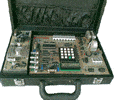

Microcontroller Kits
Programmer and Target 89s51![]()
Simple Mikrokontroller 89s51 Trainer
Standart
Mikrokontroller 89s51 Trainer![]()
Super Mikrokontroller Trainer 89s51
All Item Include
3.2. Timer/ Counter Mode 1 : 16 bit Counter
Mode 1 is the same as Mode 0, except that the Timer register is being run with all 16 bits.
Figure 3.2. Timer/Counter Mode 1: 16-Bit Counter
3.2.1. Generate pulse by using Timer 1 mode 1
By using Timer function, we can design a pulse generator and outputs data to port. as you see on figure 3.3.1., with frequency 1 Hz
Step 1st
Build the circuit as shown in figure 3.2.1. As you seen on figure 3.2.1. P0.0 is connected to LED. Remember, that all we want to do with this lesson is generate a pulse with frequency 1 Hz
Step 2nd
In this step, you must tipe the assembly program to make your Timer get action, we assume that you have already known the editor, we used MIDE-51 to edit the program. ( Download File : exp32.zip )
Figure 3.2.1. A pulse generator from timer function
Figure 3.2.2. Pulse Periode 1 second
Note that in this mode, with a 12 MHz crystal frequency, the timer overflows every 65,536 microseconds.
In this experiment, to generate interruption every 1000 micro second, then :
65536 – 10000 = 55536 d or D8F0h
Interruption will come out every 1000 x 1 microsecond = 0.01 second.
R0 is implemented as a software counter, Register R0 is incremented every Timer 0 overflows. If Register R7 detected with value 50 then port P0.0 will output data with Ton = 0,01 x 50 second = 0,5 second.
Org 0h
Start: Setb P0.0 ;P0.0 = 1
call Delay ;call delay time
Clr P0.0 ;P0.0 = 0
Sjmp Start ;Looping Forever
Delay: Mov R0,#0 ;R0 = 0
Mov TMOD,#00010000b ;mode 1, Timer 1
Load: Mov TH1, #0D8h ;TH1 = D8h
Mov TL1, #0F0h ; TL1 = F0h
Setb TR1 ; TR1 = 1, Start Running
OFlow: JNB TF1, OFlow ; jump to OFlow if TF1 =0
Inc R0 ; R0 = R0+1
CJNE R0,#50,Load;
Ret
End
Step 3rd
Safe your assembly program above, and name it with timer2.asm (for example) Compile the program that you have been save by using MIDE-51, see the software instruction.
Step 4th
Download your hex file ( timer2.hex ) into the microcontroller by using Microcontroller ATMEL ISP software, see the instruction.After download this hex file you’ll see the action of Timer( of course if your cable connection and your program are corrected ).
Comments, questions and discussion about this topic